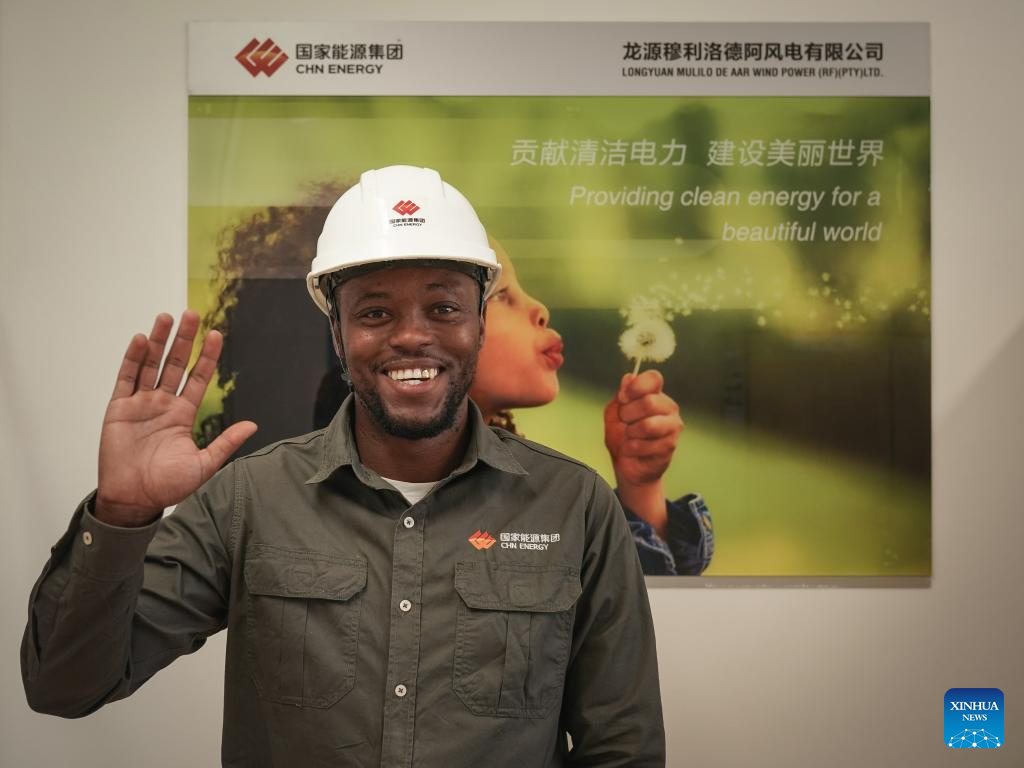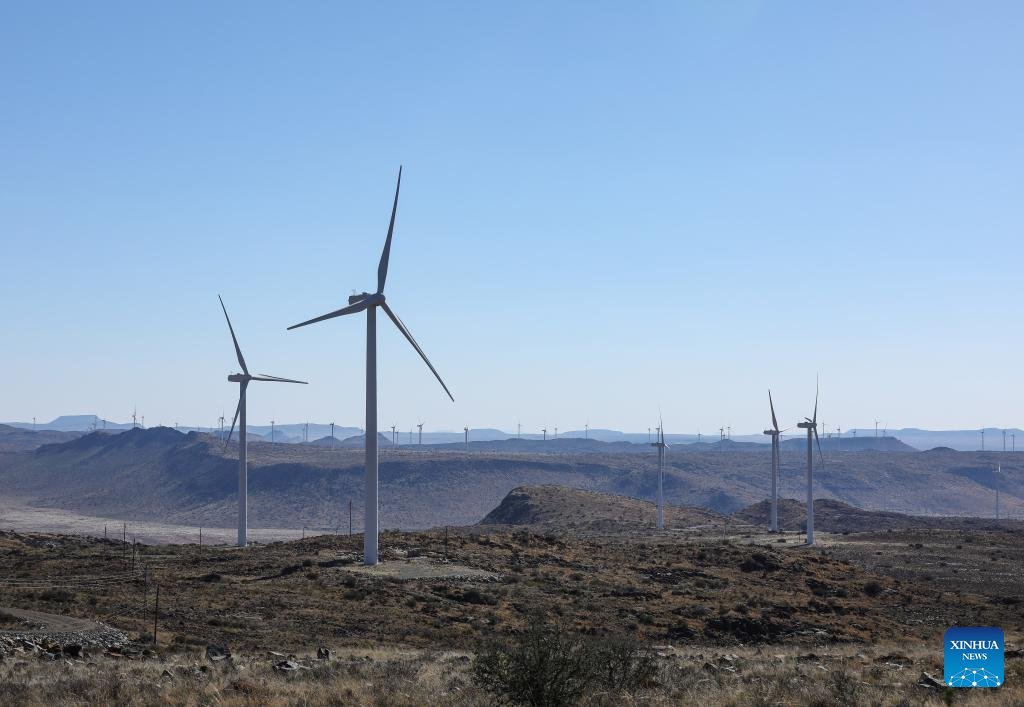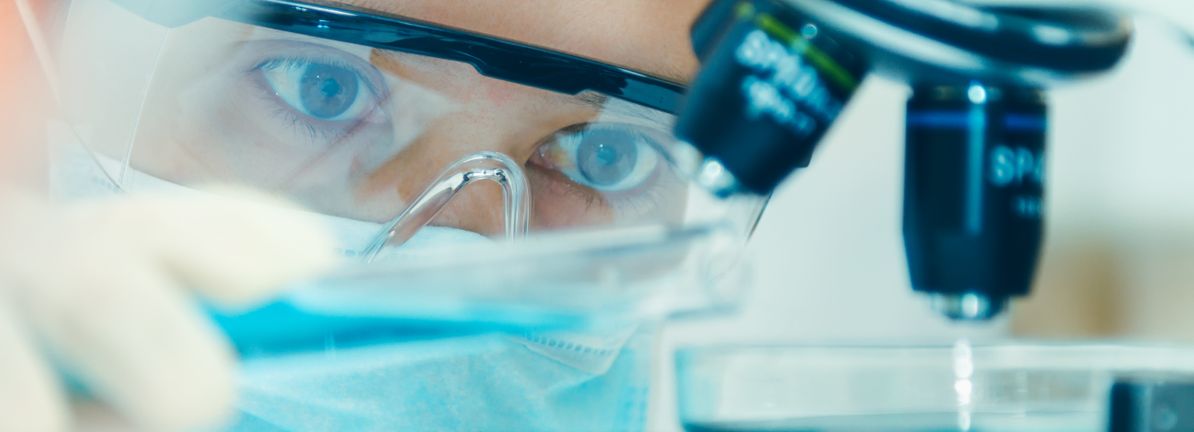This photo taken on Oct. 22, 2025 shows wind turbines of De Aar Wind Power Project in De Aar, Northern Cape, South Africa.(Xinhua/Han Xu)
by Xinhua writer Wang Lei
CAPE TOWN, Nov. 9 (Xinhua) — On a breezy afternoon across the arid plains of South Africa’s Northern Cape Province, 31-year-old Xolani Taute stood beneath a towering white wind turbine, its blades slicing through the blue sky above the small town of De Aar.
Once an unemployed electrician with little prospect of further study or steady work, he is now a trainee wind turbine technician — a testament to how renewable energy is transforming local lives.
“Longyuan has changed my life in many ways,” Taute told Xinhua, his eyes lit up with excitement. “I am very proud of what Longyuan has done here in De Aar.”
Four years ago, Taute was struggling to find work until he learned that Longyuan South Africa Renewables Ltd. (Longyuan SA), a wholly owned subsidiary of China Energy Investment Group’s (CHN Energy) Longyuan Power Group Corporation Ltd., was recruiting for its De Aar Wind Power Project. He applied and, to his surprise, was offered not just a job but a future.
Longyuan SA sponsored his training at a technical college in Cape Town. He later received hands-on training at the De Aar wind farm before joining the company in 2023 as a wind turbine technician trainee.
“They paid for my college and my accommodation, transport fee, food fee, everything,” Taute recalled.
For him, the greatest benefit to local youth like him was not simply employment but the opportunity to learn and master new technology. “By teaching people, you are giving them that skill for renewable energy,” he said. “It is like an advantage for them so that in the future they can get jobs.”
Completed in 2017, the De Aar Wind Power Project stands as a flagship example of China-South Africa cooperation under the Belt and Road Initiative.
With an investment of about 2.5 billion RMB (about 352 million U.S. dollars) and a total installed capacity of 244.5 megawatts, it is the first wind project in Africa developed, built and operated by a Chinese power company, emerging as the largest operational wind farm in South Africa. Its 163 turbines generate roughly 770 million kilowatt-hours of clean electricity each year, powering some 300,000 South African homes and easing the country’s power shortages.
Beyond delivering green energy, Longyuan SA has focused on “teaching people to fish” — nurturing local talent, improving livelihoods and stimulating regional growth.
So far, the project has trained over 110 young technicians, with more than 80 percent of its workforce now composed of local employees, many of whom hold key operational and management positions. “Now I am able to support my family, and my sisters and my brothers,” said Taute. “They changed my life.”
Thabiso Moleko, a deployment counselor with the De Aar Department of Employment and Labor, said that the wind power project has fostered skills development among local people.
“People now are having these skills,” Moleko said. “They are not only going to use them within their company but also with other companies. That means more job creation in the future, and poverty is decreasing, leading to greater economic growth in South Africa, not only in the Northern Cape but across the country as well.”
Longyuan SA also runs a scholarship program worth about 4.5 million rand (about 263,200 U.S. dollars) annually to help students from humble backgrounds pursue their education. So far, 390 students have benefited, including 30-year-old Daswin Basson, now a senior maintenance technician at the De Aar Project.
“It gave me the opportunity to build my career and make something of my life when I had no financial means to do so,” Basson said. “I hope that I can continue with that work and can continue to give young people the opportunity to grow and succeed.”
During their lunch break, Taute and Basson came to a nearby sports field — once a barren patch of dirt, now a vibrant community hub restored with funding from Longyuan SA.
“We say that ‘a child in sport is a child out of court,’ and thus it is contributing to that. Our crime has dropped, and most of our youth are enjoying this facility,” said Ronald Faul, De Aar sports facilities supervisor.
In a town with limited medical facilities, residents often spot a white mobile clinic bus making its rounds, which is another initiative by Longyuan SA.
Equipped with dental and eye-care units, the bus provides free medical services to around 9,000 residents each year and has served more than 50,000 people since its launch in 2020. Nkulukelo Mazibuko, a 29-year-old optometrist on board, said the clinic is a lifeline for many.
“Some people, especially the old people, cannot walk to the clinic. They don’t have money to go to the hospital either. When we come here, we provide service near them and it is free,” he said.
The company’s social responsibility programs also include sponsoring local old-age homes to ensure food and care for impoverished elders, building and operating early childhood centers to provide free education for hundreds of children from low-income and special-needs families, and investing millions of rand to repair the town’s water infrastructure, replacing aging pipes and cleaning reservoirs to secure safe drinking water for more than 2,000 residents.
“De Aar has really, really, really benefited so much,” said Moleko. “In the future, as a resident of the Northern Cape myself, we are really hoping to work hand in hand with the company, and we really want to see a big collaboration, want to see people working, want to see a better De Aar, want to see a better South Africa.” ■

An aerial drone photo taken on Oct. 22, 2025 shows a substation of De Aar Wind Power Project in De Aar, Northern Cape, South Africa. (Xinhua/Han Xu)

Thabiso Moleko, a deployment counselor with the De Aar Department of Employment and Labor, speaks during an interview with Xinhua in De Aar, Northern Cape, South Africa, Oct. 23, 2025. (Xinhua/Han Xu)

Daswin Basson poses for a photo at a substation of De Aar Wind Power Project in De Aar, Northern Cape, South Africa, Oct. 22, 2025.(Xinhua/Han Xu)

A teacher interacts with children at an early childhood education center operated by Longyuan South Africa Renewables Ltd. in De Aar, Northern Cape, South Africa, Oct. 22, 2025.(Xinhua/Han Xu)

This photo taken on Oct. 22, 2025 shows a mobile clinic bus purchased by Longyuan South Africa Renewables Ltd. in De Aar, Northern Cape, South Africa.(Xinhua/Han Xu)







